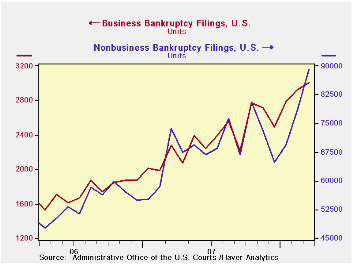 Global| Jun 23 2008
Global| Jun 23 2008U.S. Bankruptcies Surge and the 2005 Procedure
by:Tom Moeller
|in:Economy in Brief
Summary
In the wake of legislation passed in October, 2005 the rules governing the filing for bankruptcy in the United States changed dramatically. Late that year, the number of bankruptcies surged five-fold from the earlier level. The data [...]

In the wake of legislation passed in October, 2005 the rules governing the filing for bankruptcy in the United States changed dramatically. Late that year, the number of bankruptcies surged five-fold from the earlier level. The data behind these filings can be found in Haver's REGIONAL database.
Before the institution of the new procedures there was roughly a 60% correlation between personal income growth and bankruptcy filings. Corporate profit growth and non-personal bankruptcies also had roughly a 60% correlation.
Economic growth, at the time of the new rules' institution, was running at roughly a 3% real rate. On the income side of the National Income Account ledger, real disposable personal income growth was growing at nearly at a 4% rate while corporate profits were growing 12%.
The earlier procedure, for bankruptcy filing can be found here.
The situation changed dramatically in 2005 and bankruptcy filings surged five-fold. An outline of the new rules can be found here.
Since 2005, the level of total bankruptcies, business & non-business has jumped. The level of business bankruptcies has nearly doubled and personal bankruptcies also has nearly doubled. And the correlation between income and profits now is negligible.
Real disposable income growth has run at a 3% rate while profit growth ran between 3% and 12% since 2005.
The Economic Logic of a Fresh Start from the Federal Reserve Bank of Philadelphia is available here.
Testimony by Fed Vice Chairman Donald L. Cohn, Risk Management and Its Implications for Systemic Risk, can be found here.
Tom Moeller
AuthorMore in Author Profile »Prior to joining Haver Analytics in 2000, Mr. Moeller worked as the Economist at Chancellor Capital Management from 1985 to 1999. There, he developed comprehensive economic forecasts and interpreted economic data for equity and fixed income portfolio managers. Also at Chancellor, Mr. Moeller worked as an equity analyst and was responsible for researching and rating companies in the economically sensitive automobile and housing industries for investment in Chancellor’s equity portfolio. Prior to joining Chancellor, Mr. Moeller was an Economist at Citibank from 1979 to 1984. He also analyzed pricing behavior in the metals industry for the Council on Wage and Price Stability in Washington, D.C. In 1999, Mr. Moeller received the award for most accurate forecast from the Forecasters' Club of New York. From 1990 to 1992 he was President of the New York Association for Business Economists. Mr. Moeller earned an M.B.A. in Finance from Fordham University, where he graduated in 1987. He holds a Bachelor of Arts in Economics from George Washington University.






